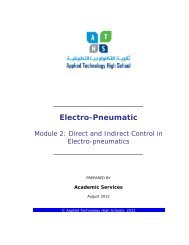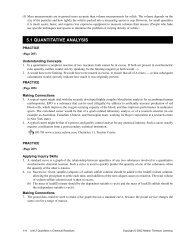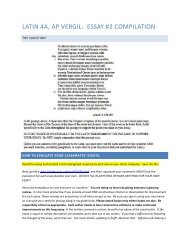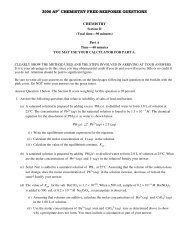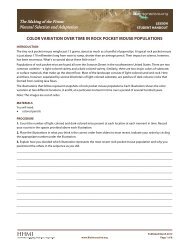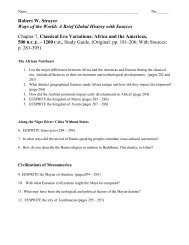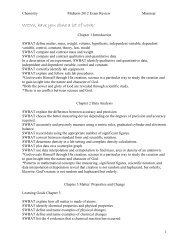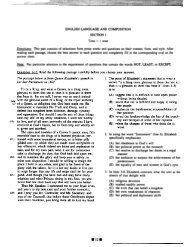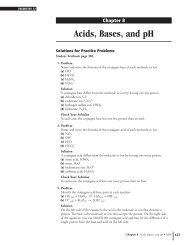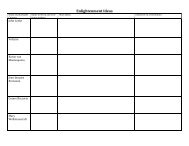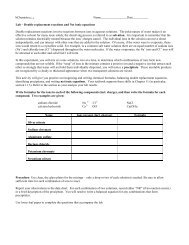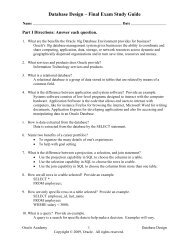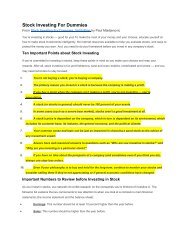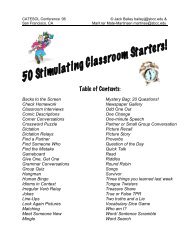Trigonometry Course Syllabus - Quia
Trigonometry Course Syllabus - Quia
Trigonometry Course Syllabus - Quia
You also want an ePaper? Increase the reach of your titles
YUMPU automatically turns print PDFs into web optimized ePapers that Google loves.
<strong>Course</strong> <strong>Syllabus</strong><br />
Trig/Analysis<br />
2012-2013<br />
Teacher: Teresa Austin<br />
Room: M205<br />
Planning Period: 4th<br />
School Phone: (276) 642-5300<br />
Email: teresaa@wcs.k12.va.us<br />
Webpage: http://www.quia.com/pages/austintrig.html<br />
<strong>Course</strong> Description<br />
This course of study is for students who are well-prepared for advanced mathematics and<br />
who will probably go on to take another higher level mathematics course, either in high<br />
school or college. Students enrolled in trigonometry are assumed to have mastered those<br />
concepts outlined in the Algebra II standards. The first semester includes a study of linear<br />
relations and functions, systems of linear equations and inequalities, the nature of graphs,<br />
including polynomial, absolute value, piecewise, greatest integer, and rational functions.<br />
Second semester will provide a thorough treatment of trigonometry through the study of<br />
trigonometric definitions, applications, graphing, trigonometric identities, and solving<br />
trigonometric equations and inequalities. Emphasis will also be placed on using connections<br />
between right triangle ratios, trigonometric functions, and circular functions. In addition,<br />
applications and modeling will be included throughout the course of study. Applications of<br />
the unit circle are explored along with the study of the law cosines and the law of sines.<br />
The second semester will also include a study of logarithmic functions, and exponential<br />
functions and their graphs.<br />
<strong>Course</strong> Planner<br />
1. Equations and Inequalities<br />
2. Functions and Their Graphs<br />
3. Linear and Quadratic Functions<br />
4. Polynomial and Rational functions<br />
5. Exponential and logarithmic function<br />
6. Trigonometric functions<br />
7. Analytic <strong>Trigonometry</strong><br />
8. Applications of Trigonometric Functions
Materials<br />
Three ring binder<br />
Notebook paper<br />
Graph paper<br />
Pencil<br />
Graphing calculator Casio (optional)<br />
Grade System<br />
A 93-100<br />
B 85-92<br />
C 77-84<br />
D 70-76<br />
F Below 70<br />
Grades will be determined by:<br />
Tests will be given at the end of chapters or major content areas. Each<br />
student will earn a *daily grade/participation grade, which will count as one<br />
test grade for the nine weeks. The average of your tests and daily grade<br />
will count 30% of the nine week average.<br />
Quizzes will be given more often than tests and will cover a smaller content<br />
area, such as one or two homework assignments. There will be approximately<br />
two per week after homework has been reviewed, checked, student<br />
questions have been answered, and further explanation has been given. The<br />
average of all quizzes will count 30% of the nine week average.<br />
Notebook quizzes will be given has a random check of students notes and<br />
homework. All notes that are given in class should be in each student’s<br />
notebook along with all homework assignments with correct work and<br />
solutions. This notebook should be brought to class each day. During a<br />
notebook quiz, only the student’s notebook will be used to find answers for<br />
the quiz. It is the student’s responsibility to get notes and homework<br />
assignments for classes they do not attend. All notes are posted on the class<br />
webpage daily. Notebook quizzes will count 15% of the nine week average.<br />
Homework will be assigned on almost a daily basis. Homework will be<br />
checked for completeness as I walk around the room, collected and returned<br />
the following day, or a homework quiz will be given for each assignment.<br />
Completing and correcting homework to the best of your ability is essential<br />
to learning the concepts of this class. If homework is checked as I walk<br />
around the room the grade will be entered as a part of your *daily grade<br />
(mentioned above). If it is collected or a quiz is given it will be a grade of<br />
its own not to be combined with the daily grade. Homework grades will count<br />
25% of the nine weeks grade.<br />
*Daily grade/participation grade reflects the student’s ability to be on time to class,<br />
complete homework and class assignments, bring materials to class, always do their own
work, follow school rules during class time, and generally follow directions and reasonable<br />
requests. Students begin each nine weeks with a 100 daily grade. Violations of the below<br />
expectations will result in points being deducted from the original 100. The outcome is one<br />
test grade.<br />
Math Department Classroom Expectations/Daily Grade<br />
1. Be on time to class. Class will begin at the bell. On the third tardy and for all<br />
tardies thereafter students will be assigned after school detention or referred to<br />
the assistant principal as school policy requires. (2 pts)<br />
2. Have all homework assignments ready to turn in BEFORE class begins. Homework<br />
will be assigned daily. You are expected to write each question, show all work,<br />
attempt every question, and correct each incorrect solution. After 3<br />
homework/class work deficiencies and all homework/class work deficiencies<br />
thereafter per nine weeks the student will be assigned after school detention. An<br />
attempt to contact the parent will be made on the 2 nd homework/class work<br />
deficiency. (2 pts)<br />
3. Bring all materials to class. This includes pencil, math notebook, paper, textbook,<br />
and workbook. (2 pts)<br />
4. Leave all food and drinks outside of the classroom. (2 pts)<br />
5. Use the restroom and get water BEFORE class begins.<br />
6. Follow directions, listen carefully, work quietly, and be respectful to your peers and<br />
teacher. (2-5 pts)<br />
7. Do your own work at all times. (5 pts)<br />
John S. Battle Make Up Policy<br />
A student is expected to make up all work missed regardless of the reason for the absence.<br />
At no time is a student to miss additional class time to make up work. The student is<br />
responsible to find out from the teacher what work they have missed when they return to<br />
school from his/her absence. Parents are strongly encouraged to make contact with the<br />
school during the student’s absence to solicit make-up work. Students have (3) days to<br />
make up work if they have been absent (3) or fewer days. Failure to complete make-up work<br />
will result in lowering of student’s grade. Students have an additional day to make up their<br />
work for each additional day absent. Any work not completed by the end of the grading<br />
period, teacher are to assign an F on the grade card, not an I for incomplete. These F<br />
grades due to an incomplete may be changed once the work has been made up to the<br />
teacher’s satisfaction.
Parent and Student Signature<br />
Please read the syllabus with your child. If you understand the requirements and<br />
procedures of this class, please sign the form, separate it from the syllabus, and return it<br />
to Mrs. Austin the next class meeting. If you have questions, please contact me. The<br />
syllabus will be kept in the student’s binder for review throughout the year.<br />
Student Name (Print) ___________________________________________<br />
Student Name (Signature)________________________________________<br />
Parent Name (Print)_____________________________________________<br />
Parent Name (Signature)__________________________________________<br />
Date_______________________________



